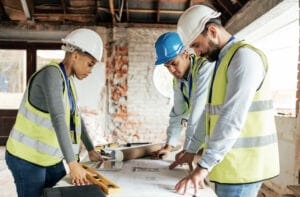In the wake of the 2008 financial crisis, Arizona charted a new course to diversify its economy, attracting businesses in the semiconductor, electric vehicle and advanced manufacturing industries. These investments will provide jobs for locals but will also bring new families — and students — to the Grand Canyon State. Fred Bueler, vice president at Chasse Building Team, says that the southwest, northwest and southeast reaches of Greater Phoenix are experiencing the highest rates of growth and seeing an influx of new education facilities coming out of the ground.
“We’ve seen a lot of schools that we’ve built in the Valley in the last three or four years that are already at capacity. They’re now moving onto the next phase where they’re adding additional classrooms,” Bueler explains.
Arizona is also known as a leader in school choice, and Maria Baier, vice president of development at Great Hearts Academies, notes that in the charter’s two-decade history, it has opened 22 schools in the Greater Phoenix.
“Across the network here in Arizona, we have 15,363 students, and we have another 6,789 on waiting lists. As a public charter school, if there’s a seat open, it’s available to any student. In other words, there’s no tuition, there’s no admission requirements, no testing or anything,” Baier says. “We keep trying to find good sites to build in areas where there remains a need. We’re even starting to have preschools at our new campuses because there’s a real deficit of those in the Valley.”
Even though building has progressed at a steady clip throughout the past five years, Bueler notes that population growth projections indicate the continued need for schools in places such as Queen Creek, Buckeye, North Peoria, Goodyear and the Mesa Gateway area.
The construction of new education facilities presents the opportunity for improving learning spaces to foster student development in novel ways, while also prioritizing the safety of everyone on campus.
Next generation education facilities
The traditional classroom evokes an image of sanitized efficiency — columns of identical desks all facing the whiteboard at the front of the room. Bueler notes that educators and designers have found that such a configuration isn’t the best learning environment and are looking for ways to keep facilities relevant not just for today’s students, but those in the coming years.
“The trend over the last five years is classroom flexibility,” he continues. “Instead of four closed walls, you’re seeing one [wall] be a glass partition that can open into the corridor. Rather than just being a hallway, these corridors are turning into learning spaces. A teacher can open the glass wall and put students in that corridor where they can have a breakout session, but still be observed by the teacher.”
READ ALSO: Is team-teaching the future of education?
Having adaptable classrooms allows them to be easily reconfigured if an instructor wants to group students in pods of desks for a specific activity or to use outside normal school hours by a community group. The emphasis on flexibility is part of what Antonya Williams, executive vice president of operations at McCarthy Building Companies, calls “next generation learning.”
Another area of focus is creating a stronger connection between indoors and outdoors. “If you went to school in the ‘80s, you probably didn’t have a lot of windows and daylight in your classroom,” Williams says. Today, Bueler adds, designers are also trying to take advantage of Arizona’s beautiful weather during the winter months by bringing the classroom outdoors, and vice versa.
Technology has been part of the learning process for some time now, but the degree of integration has accelerated. Students are often assigned individual laptops or tablets to complete assignments and collaborate online. Williams notes that the emphasis on technology in daily life has morphed how libraries are designed, with a reduced emphasis on physical books in lieu of connections to digital media.
Safety
During the school year, parents entrust the wellbeing and development of their children to educational institutions. Those schools take their duty to ensure students flourish intellectually in a safe environment seriously, and one facet of protecting them is the security of the campus itself.
“The focus on safety is No. 1 in the education space right now, whether it’s a new build or an upgrade project,” Williams explains. “The [layout of] points of entry into a school, how doors lock and are connected, and intercom systems are all part of the security of schools.”
The most porous entry of most schools is through the administrative building at the front of the campus. More doors and glass barriers are being installed to control that point of access. Perimeter fencing also controls the flow in and out of the facility.
“At my daughter’s school,” Williams says, “there’s one point of entry through one fence. If you have a meeting with a teacher, there is a clear check-in process at the main office. What I experience on a daily basis dropping her off at school is reflective of what we’re seeing being integrated in projects from a safety and security standpoint.”
Just because a campus is secure doesn’t mean it looks or feels like a prison, she adds. “It’s incredible what solutions our design partners are coming up with to create clarity and streamline drop offs, while having more daylight and connectivity [inside the grounds]. We are building schools that are beautiful and safe — there’s no tension between those two [goals].”
Bueler notes that the only way these education facilities get built — especially with the rising costs of construction — is through the backing of the community.
“We want to make sure our students and teachers have the best facilities possible. Lots of companies are relocating their headquarters here and recruiting [them] requires a great educational system,” he concludes. “It’s going to take the support of the community when school districts have bonds to pass to make sure we provide for our students and the future generations to come.”




